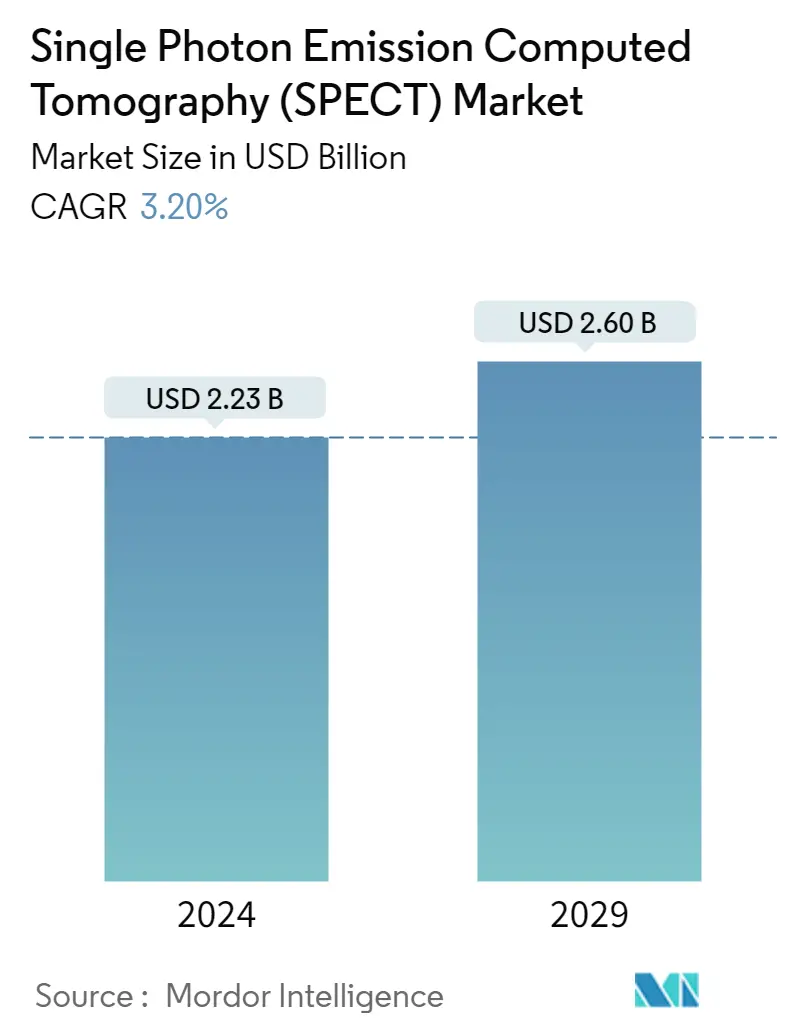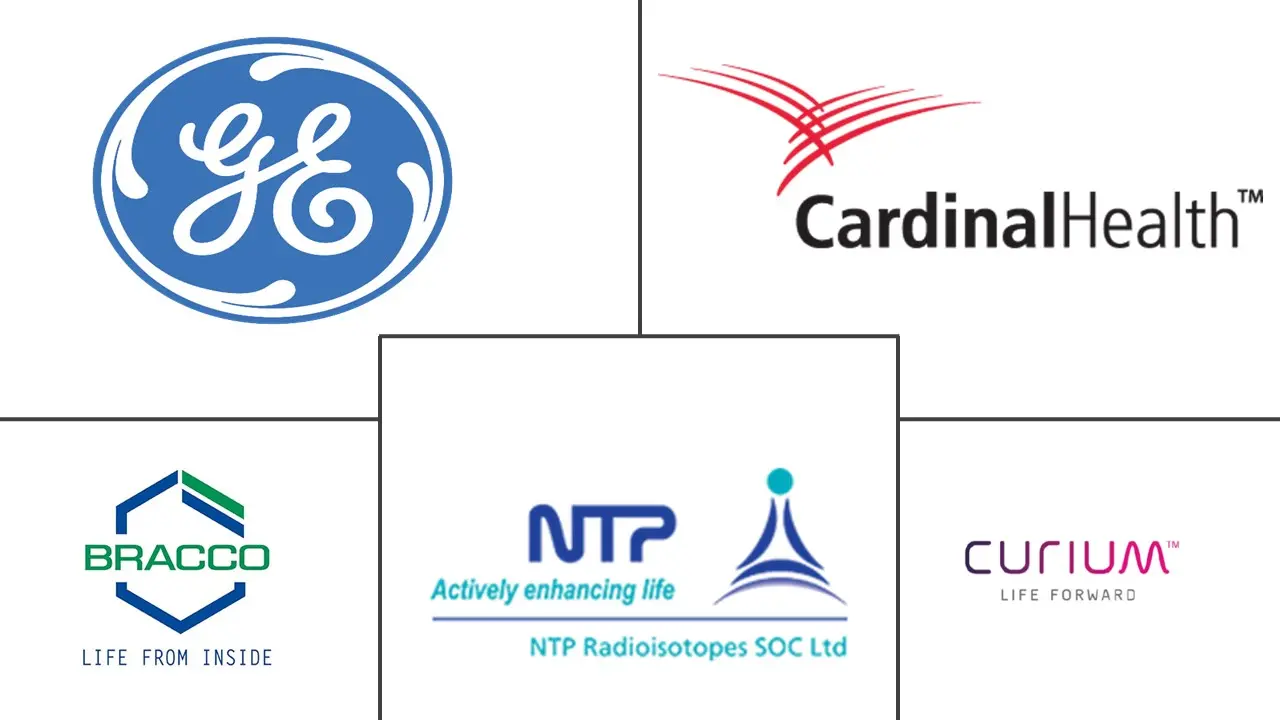
| Study Period | 2019 - 2029 |
| Market Size (2024) | USD 2.23 Billion |
| Market Size (2029) | USD 2.60 Billion |
| CAGR (2024 - 2029) | 3.20 % |
| Fastest Growing Market | Asia Pacific |
| Largest Market | North America |
| Market Concentration | Medium |
Major Players
*Disclaimer: Major Players sorted in no particular order |
Single-Photon Emission Computed Tomography (SPECT) Market Analysis
The Single Photon Emission Computed Tomography Market size is estimated at USD 2.23 billion in 2024, and is expected to reach USD 2.60 billion by 2029, growing at a CAGR of 3.20% during the forecast period (2024-2029).
COVID-19 has a huge impact on the patients as they became self-selective in a way that they canceled their nuclear imaging procedures, which were categorized as nonessential. This pandemic affected the operations of hospitals and doctors, as they were also prioritizing their procedures and postponed a number of elective surgeries and radiation treatments, due to which there was a decrease in the demand for related SPECT scans. Besides the negative impact of COVID-19, it has created opportunities for players in this field to establish their presence by launching new products or progressing clinical studies in this field. For instance, in November 2020, NanoMab Technology Limited received CTA Acceptance from the Medicines Healthcare products Regulatory Agency (MHRA) to carry out a Phase II clinical Study for its NM-01 product. This study will assess the programmed death-ligand 1 (PD-L1) expression using 99mTc-NM-01 as a SPECT/CT radiotracer and its correlation to PD-L1 expression results based on routine immunohistochemical (IHC) testing in biopsy diagnostic specimens.
Single-photon emission computed tomography (SPECT) is used in the evaluation of disease processes based on functional and metabolic information of organs and cells. The most widely used SPECT systems are based on the anger gamma camera, usually involving dual detectors that rotate around the patient. The application of hybrid equipment and fused techniques has increasing importance in the field of imaging diagnostics. One of the most significant advantages of these methods is the simultaneous use of several modalities, which can give data about the morphological, functional, and molecular changes of the different diseases at the same time.
The rising prevalence of cases of cancer, such as breast cancer and prostate cancer, is likely to enhance the market growth significantly in the future. For instance, as per the report of the American Cancer Society, in 2021, there were an estimated 1,898,160 new cancer cases diagnosed and 608,570 cancer deaths in the United States.
The integration of X-ray computed tomography (CT) into SPECT recently emerged as an essential diagnostic tool in medical imaging, where anatomical details may delineate functional and metabolic information. For instance, according to research published in January 2022 in the American Association of Physicists in Medicine titled "Optimization of 99mTc whole-body SPECT/CT image quality: A phantom study," single-photon emission computed tomography (SPECT) combined with X-ray computed tomography (SPECT/CT) yields information on both physiology (SPECT) and anatomy (CT).
Furthermore, there is an increasing trend of dual-modality systems and organ-specific systems to enhance the diagnostic capability of the equipment. In the past several years, there has been growing utilization of PET/CT, owing to the fact that functional and morphologic correlative images produced by this methodology improve diagnostic accuracy, and it is one of the factors that can impede the growth of the SPECT equipment market. However, the shorter half-life of radioisotopes and stringent regulatory guidelines are a few market restraints that hinder the growth of the market. However, owing to all factors mentioned above, the market is expected to witness satisfactory growth over the forecast period.
Single-Photon Emission Computed Tomography (SPECT) Industry Segmentation
As per the scope of the report, single-photon emission computed tomography (SPECT) is a nuclear imaging technique that uses radioactive tracers and a scanner to record data, which a computer constructs into two or three-dimensional images. SPECT has reportedly been combined with CT and MRI to provide detailed anatomical and metabolic information. The single-photon emission computed tomography (SPECT) market is segmented by type of radioisotope (Tc-99m, Ra-223, Ga-67, I-123, and other types of radioisotopes), application (oncology, cardiology, neurology, and other applications), and geography (North America, Europe, Asia-Pacific, Middle-East and Africa, and South America). The market report also covers the estimated market sizes and trends for 17 different countries across major regions globally. The report offers the value (in USD million) for the above segments.
| Tc-99m |
| Ra-223 |
| Ga-67 |
| I-123 |
| Other Types of Radioisotopes |
| Oncology |
| Cardiology |
| Neurology |
| Other Applications |
| North America | United States |
| Canada | |
| Mexico | |
| Europe | Germany |
| United Kingdom | |
| France | |
| Italy | |
| Spain | |
| Rest of Europe | |
| Asia-Pacific | China |
| Japan | |
| India | |
| Australia | |
| South Korea | |
| Rest of Asia-Pacific | |
| Middle-East and Africa | GCC |
| South Africa | |
| Rest of Middle-East and Africa | |
| South America | Brazil |
| Argentina | |
| Rest of South America |
Single Photon Emission Computed Tomography (SPECT) Market Size Summary
The single-photon emission computed tomography (SPECT) market is poised for growth, driven by advancements in imaging technology and the increasing prevalence of cancer and bone disorders. SPECT, which evaluates disease processes through functional and metabolic information, is gaining traction due to its integration with hybrid imaging systems like SPECT/CT. These systems offer comprehensive data on morphological, functional, and molecular changes, enhancing diagnostic accuracy. The market is also witnessing the introduction of new radiopharmaceuticals and the development of molecular imaging, which are expected to propel its expansion. Despite challenges such as the shorter half-life of radioisotopes and stringent regulatory guidelines, the market is anticipated to experience satisfactory growth over the forecast period.
The United States plays a significant role in the SPECT market, supported by substantial investments in cancer research and treatment. The introduction of innovative products, such as digital solid-state cardiac SPECT systems and new SPECT agents, is further boosting market growth. Key players in the industry, including Koninklijke Philips NV, Siemens AG, and GE Healthcare, are actively contributing to the market's development. Collaborations and acquisitions, such as Bayer's acquisition of Noria Therapeutics Inc. and PSMA Therapeutics Inc., are also shaping the competitive landscape. As the global burden of chronic diseases rises, the significance of SPECT in diagnostics is expected to attract new entrants to the market, fostering a competitive environment.
Single Photon Emission Computed Tomography (SPECT) Market Size - Table of Contents
1. MARKET DYNAMICS
- 1.1 Market Overview
-
1.2 Market Drivers
- 1.2.1 Increasing Demand for SPECT Analysis in Radiopharmaceuticals
- 1.2.2 Growing Geriatric Population
- 1.2.3 Improvements in SPECT Imaging Technology
-
1.3 Market Restraints
- 1.3.1 Shorter Half-life of Radioisotopes
- 1.3.2 Stringent Regulatory Guidelines
-
1.4 Porter's Five Forces Analysis
- 1.4.1 Threat of New Entrants
- 1.4.2 Bargaining Power of Buyers/Consumers
- 1.4.3 Bargaining Power of Suppliers
- 1.4.4 Threat of Substitute Products
- 1.4.5 Intensity of Competitive Rivalry
2. MARKET SEGMENTATION (Market Size by Value - USD million)
-
2.1 By Type of Radioisotopes
- 2.1.1 Tc-99m
- 2.1.2 Ra-223
- 2.1.3 Ga-67
- 2.1.4 I-123
- 2.1.5 Other Types of Radioisotopes
-
2.2 By Application
- 2.2.1 Oncology
- 2.2.2 Cardiology
- 2.2.3 Neurology
- 2.2.4 Other Applications
-
2.3 By Geography
- 2.3.1 North America
- 2.3.1.1 United States
- 2.3.1.2 Canada
- 2.3.1.3 Mexico
- 2.3.2 Europe
- 2.3.2.1 Germany
- 2.3.2.2 United Kingdom
- 2.3.2.3 France
- 2.3.2.4 Italy
- 2.3.2.5 Spain
- 2.3.2.6 Rest of Europe
- 2.3.3 Asia-Pacific
- 2.3.3.1 China
- 2.3.3.2 Japan
- 2.3.3.3 India
- 2.3.3.4 Australia
- 2.3.3.5 South Korea
- 2.3.3.6 Rest of Asia-Pacific
- 2.3.4 Middle-East and Africa
- 2.3.4.1 GCC
- 2.3.4.2 South Africa
- 2.3.4.3 Rest of Middle-East and Africa
- 2.3.5 South America
- 2.3.5.1 Brazil
- 2.3.5.2 Argentina
- 2.3.5.3 Rest of South America
Single-Photon Emission Computed Tomography (SPECT) Market Research FAQs
How big is the Single Photon Emission Computed Tomography (SPECT) Market?
The Single Photon Emission Computed Tomography (SPECT) Market size is expected to reach USD 2.30 billion in 2025 and grow at a CAGR of 3.20% to reach USD 2.69 billion by 2030.
What is the current Single Photon Emission Computed Tomography (SPECT) Market size?
In 2025, the Single Photon Emission Computed Tomography (SPECT) Market size is expected to reach USD 2.30 billion.


